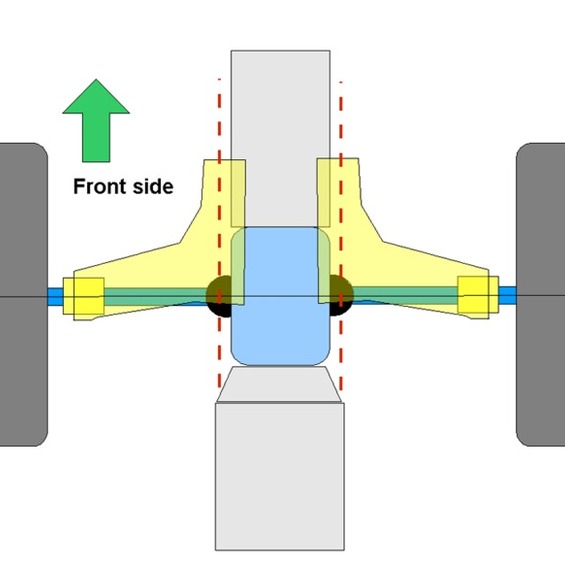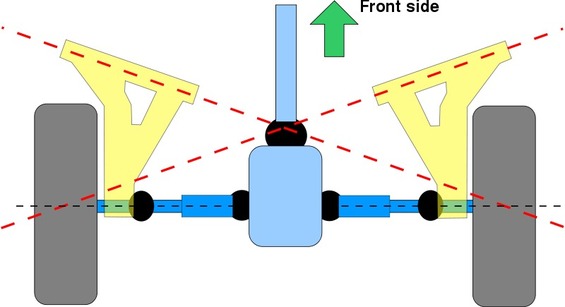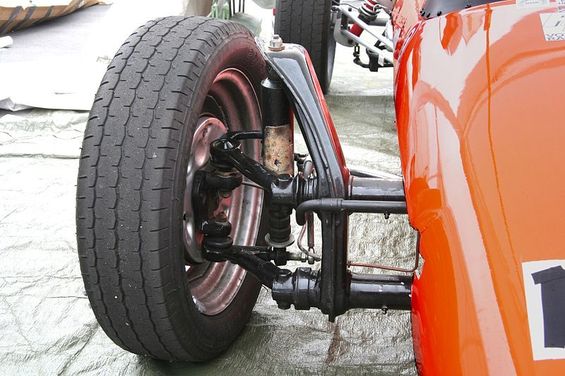
In the general classification, the vehicle suspension is divided into two types: dependent and independent. The main feature of the dependent suspension is that two wheels on the same axis are rigidly connected to each other. There is no common axis in the independent suspension. As a result, the controllability and overall comfort of the driver in cars with such suspension are significantly higher. Types of independent suspension
Types of independent suspension
Suspension Bridey semiaxial
Built, as the name is clear, on the supply-joints with half-axes. It was used in combination with springs, but it did not receive much distribution at the expense of imperfection-too much degree of freedom is given to wheels, which is not the best influence on controllability.

Given these features, vehicles with rear axle-driven vehicles were most likely to be provided with this suspension. This suspension was applied in particular at the rear in the domestic "Gorbat" Zaporizhzka ZAZ-956.
Longituders suspension
This type of suspension is simple enough to make it widely available. It is clear from the name that the basis of the structure is the longitudinal levers attached to the body, having the ability to swing up and down. The drawback of such suspension was and remains its relative dependency, as the wheel on the opposite side of the body rises too much, partly losing the grip of the road. Due to this negative quality, it is found mainly on the rear axle of the front-wheel-drive vehicles. This type of suspension in the second half of the twentieth century was equipped with Citroen vehicles and other "French". The relative dignity of the longitudinal levers can be considered as having little or no space under the bodywork, allowing the volume of the boot to be increased.

In the eighties, the suspension on the longitudinal levers was gradually replaced by the "Macpherson" system and, later, by the suspension on the double transverse levers.
McPherson suspension
The most common form of independent suspension. Often used in the front axle of the car, whether or not the driving axis is the anchor. The McPherson suspension is a variant of the double transverse lever where the upper transverse lever is removed and the second leg is the depreciating frame.

The compactness of the McPherson suspension allows the construction to be successfully carried out on the front-wheel-drive cars, as it does not interfere with the installation of the engine and the carton and leaves enough room for the leading actuators (SHUS).
The suspension on the braids
This is a modification of the suspension on the longitudinal levers created in an effort to save the design from "congenital diseases". The control levers are called because they are not installed strictly parallel to the body, but at a certain angle, which prevents the wheels from "leaving" perpendicular to the axis of the movement of the direction. This has led to increased manageability in comparison to vehicles with longitudinal levers. You can see the leverage in the early cars of the third series, Ford Granada, Sierra, and Scorpio, that is, on the back-drive models.

Longituders on the double longitudinal levers
The type of suspension with two longitudinal levers on each side is rare in our time. Used mainly on the front axle of the rear-engine cars. The most vivid example of "Volkswagen Zhuk" and the first two generations of minibuses "Transporter".

This kind of suspension of the world is owed to the unnamed Ferdinand Porsche. In the domestic automobile history, the most famous example of application is the construction of the suspension of the front axle "Brokebatsky" Zaporozhzka. Motorists with long experience are likely to remember the tubes of peat tubes having the role of elastic elements in the suspension of the ZO-956, the most visible part of it, but they hardly know that they are exactly the basis of the Porsche system with the dual longitudinal levers
Double-side suspension
In this structure, on each side of the vehicle, there are two transverse levers, one end of the movable fixed on the body, the imitation or the frame, and the second, external, on the rack, to which either the pivoting wheel (front axle) or the hub (rear axle) is attached.

The main advantage of the suspension of this type is the possibility even without adjustment screws or other elements, the selection of the length of the levers, all the basic characteristics (for example, the parameters of the wheel spread). Due to this critical factor in most modern vehicles, both the front and rear axles are based on the principle of two levers.
Active suspension
In principle, the suspension of this type may be a variation of any of the above. The essence of the concept reflected in the title is the ability to change the position and rigidity of the elements working for the command from the control unit. Based on pneumatic cylinders, hydraulic or pneumatic cylinders. In passenger cars, it is rare because of complexity and high cost. A classic example is the system of changing the climate that can be found in Citroen cars, from DS to the mid-50s, to Xantia.
Pros and cons of independent suspension
Low weight of the unbroken masses. The weight of all the suspension elements (including the weight of the wheel) is considered unbroken. The lower the weight, the better the suspension works, the oscillation is lighter, the longer "life" of the suspension elements.
More suspension options.
Better management and clutch at high speeds.
It's more complicated and more complicated and more expensive and more expensive.







